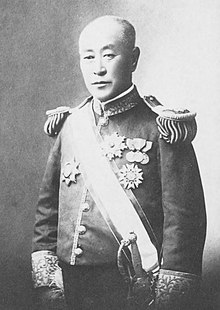 |
| Inoue Masaru |
Have you ever heard of Inoue Masaru, who is called the “Father of Japan’s Railways? He was one of the Choshu five, who went to study abroad while it was still illegal to leave Japan. He was born on August 24th in 1843 at Hagi in Yamaguchi prefecture, in southern Japan. He was brought up as a samurai belonging to the Choshu clan who controlled that area. In 1863, however, he and four friends from Choshu clan sneaked into a vessel which went to the UK. He studied civil engineering and mining at University College London and came back to Japan in 1868. After he came back, he took a leadership in Japan’s railway planning and construction, and he was appointed the Director of the Railway Board in 1871. He thought railways should be under national control, and he worked for a creation of the Railway Nationalization Act. He died of an illness in London in 1910, during an official visit on behalf of the Ministry of Railways. Thanks to him, Japanese railway developed and made our life convenient. Without him, it would have been more difficult for Japan to develop in that time, and also we might not have a good train system today.
One of the most important things which he did was making the first railway in Japan. In 1872, the government decided to make a railway, and he was appointed the supervisor because he saw many techniques about it in London. He often went to the construction field and gave instructions by himself. In 1875, the first railway was opened between Shinbashi and Yokohama, which are famous places around Tokyo. The Meiji emperor rode on the rail and told him to expand the railway system throughout Japan, so he was inspired and made more efforts after that. To build up a railway between Kyoto and Otsu, which are located in middle parts of Japan, a tunnel construction was needed, but it was such a difficult work. In addition, it was said that it was impossible to build a tunnel by Japanese without foreign help, but he succeeded in making it only by Japanese people in 1883. In 1892, he finally finished making the Tokaido line between Tokyo and Kobe, located in the centre of Japan. There were no other people who had much knowledge about the railway except him, so he worked hard to expand the railways. In 1894, the railway between Ueno located in Tokyo and Aomori in the north of Japan was also opened.
Why did he work so hard for making the railway? In that time, transportation system in Japan wasn’t good, and walking was the main way for the transportation. There was a mikoshi which is a box carried by people, but only rich people used it. Also, only samurai officers used war-horses. For most people, there was no other useful transportation but walking, so he thought Japan needed the railway. Though horse carts and jinrikisha were developing, he thought they were not enough. He was hoping that the railway system would make life more convenient and also bring in benefits for the Japanese economy. The railway made it possible for people to travel all over Japan, and people exchanged their materials and information with other Japanese so that they could help each other more. That’s why he worked so hard for the railway system.
He resigned as the director in 1893, but he kept working for the railway. In that time, the railway was developing, but it relied on foreign techniques and materials. Thus, Japan needed to pay much money to foreign countries. Then he thought Japan needed the technique which was made and used by Japanese. He cooperated with some of his friends such as Mori and Iwasaki, who were rich and had good education, and they established a new company called “Train production firm company” in 1896. The company built plants in Osaka and got orders for making trains. Thanks to the demand of the railway caused by Russo-Japan War, the company got many orders and became a big company. Also, other companies were established after that, which improved Japanese railway techniques.
He died in London in 1910 while he was visiting there as studying railways. Through his life, he worked for Japanese railway system, and he improved Japanese transportation system. In 1914, his statue was made at Marunouchi station, which is a famous place in Tokyo, to admire his achievement. Without him, Japanese railway would not really have developed, and transportation system would have been inconvenient. Thanks to his great effort, Japan got a railway made in Japan, which brought large benefits to Japanese economy and helped Japan develop. Our life would be so different from now if he hadn’t gone to the UK, so we should thank him for his courage in that time.
References
Hidaka Olion, (2010). Father of the railway: Inoue Masaru ~persistence to Made in japan~. Retrieved from http://www13.ocn.ne.jp/~dawn/ on July 25, 2013
Toshikazu, K, (2012). The railway initiation history of Inoue Masaru. Retrieved from http://ktymtskz.my.coocan.jp/denki/inoue.htm on July 25, 2013
No comments:
Post a Comment